Political cartoons that made a difference and shook the nation in the 1950s
Posted on August 3rd, 2015
by Senaka Weeraratna
Aubrey Collette was a well known cartoonist from the mid forties who was virtually a regular contributor to the Times of Ceylon and the Lake House press until the early 1960s when he emigrated to Australia.
His cartoons comprised a sharp, visual comment on the social and political landscape of the time. Notable issues of the moment, the political developments after Sri Lanka’s independence and the far-reaching social and cultural changes in the 1950s found expression in his line-work.
Unfortunately though he was a talented Artist he found himself looking at the passing political scene through the eyes of an observer who could not appreciate nor sympathise with the growing public disenchantment with the ‘ Brown Sahib’ approach to governance, press freedom and life styles.
Aubrey Collette was not alone in this respect. The lack of sensitivity of local Journalists attached mainly to English language newspapers, to the traditional culture, national history. Buddhism and ways of living of the Sinhalese people was described by the Press Commission headed by Justice K.D. de Silva in the following terms:
‘ In Ceylon many of the Journalists, especially of the English language Press, have other shortcomings. Most of them have been educated in Roman Catholic missionary schools; some are seminarists, having completed that education in Europe. They not only do most of the writing in the English Press but lay down policy for the Sinhala and Tamil papers as well. Missionary education was an imperialist device meant to condition the recipient to accept the Graeco – Roman – Christian tradition which goes as European and Western civilisation, as something superior. The European missionary, in following his mission, had perforce to look down upon and decry Eastern civilisation. His system of education fully ensured that. The missionary educated journalists took for their standards those of the West. That our only international news, photographs, and feature articles come through the Reuter’s London sieve, is of immense help to him. They are accepted without question. An article in the Time Magazine or Osservatore Romano is good copy and gives him the line on any controversial international event. Any news from other sources is brushed aside as so much propaganda. ” (PCR para 200, page 85)
Lack of impartiality and fairness
- B. Dhanapala, a leading Journalist and Editor of the Dawasa, in an article published in the ‘ Ceylon Today ‘ November 1961, said as follows:
‘ There is no other country in the whole of the East, perhaps, where the Press as a whole has acted with such utter contempt for objectivity, impartiality and fairness as in Ceylon in recent years often going so far as the very invention of bogus news ” (PCR para 198, (page 84)
Cartoons of Aubrey Collette
The following sketches reveal a level of contempt for indigenous ideas, policies and leaders such as S.W.R.D. Bandaranaike and L.H. Mettananda. In fact these cartoons also contributed to a sense of alienation that the majority of the people felt in the 1950s that led to the electoral revolution of 1956.
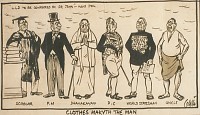
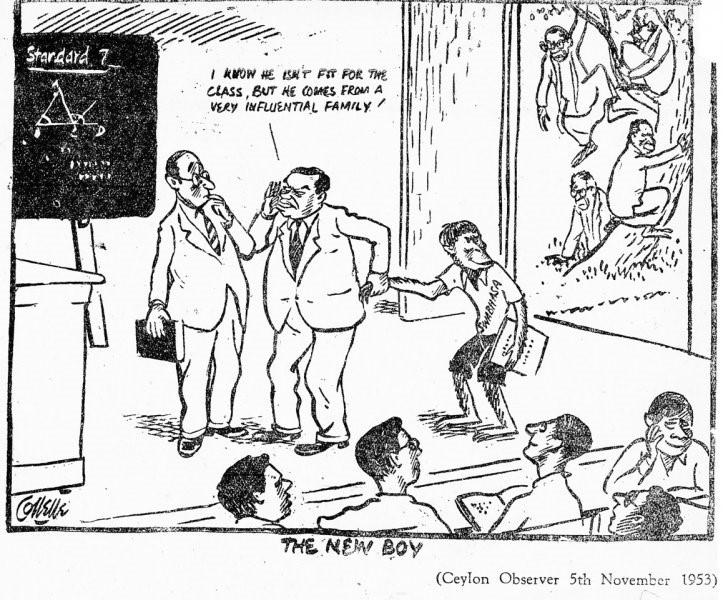
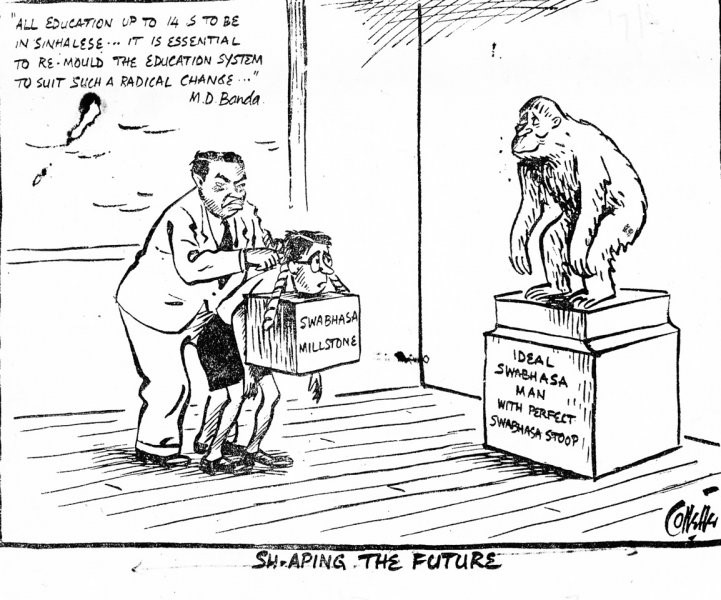
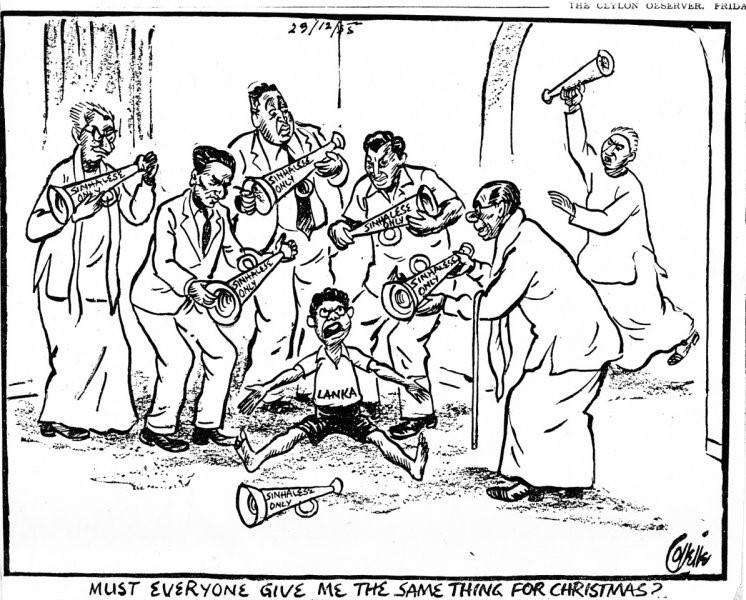
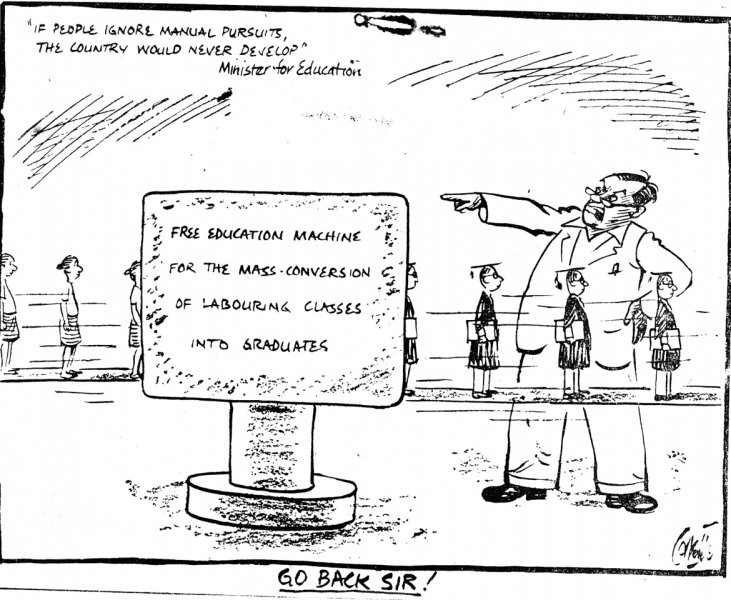
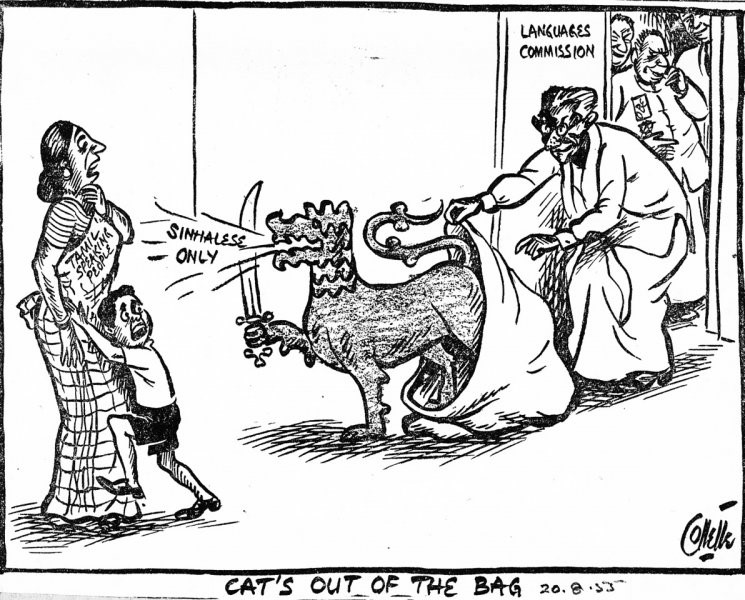
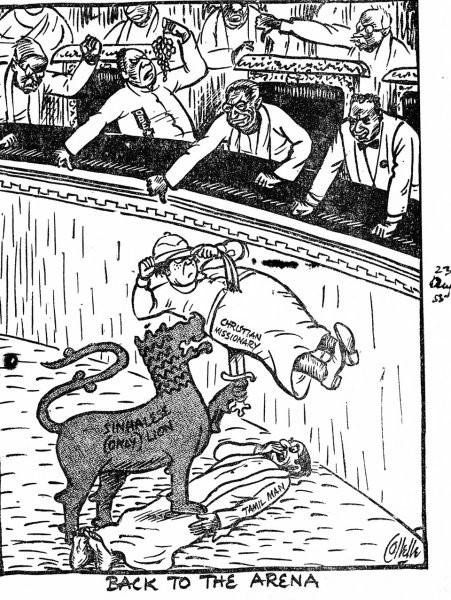
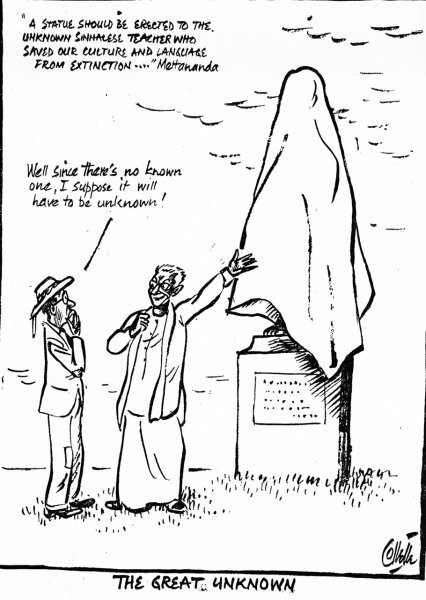
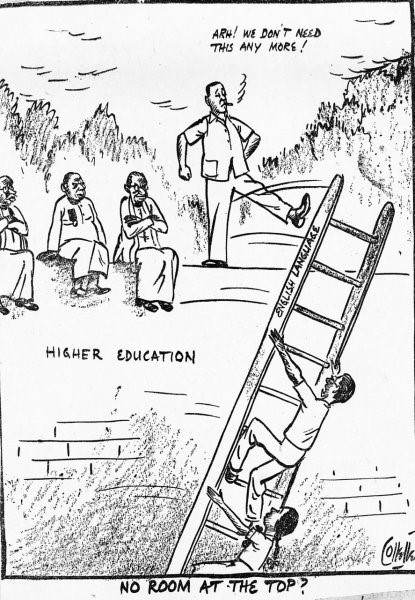
Counter culture cartoons
‘ Mara Yuddhaya’ (‘ The Struggle with Satan’)
published by the Eksath Bhikku Peramuna.
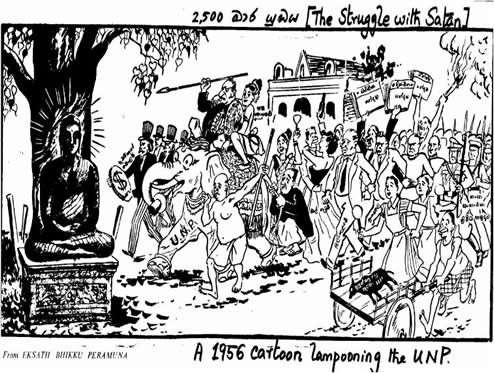
The cartoon that sealed the fate of the UNP in 1956
In this gripping cartoon the artist captures poignantly
the alienation of the rulers and the westernised social class
from the country’s mainstream Buddhist culture and heritage.
Sir John Kotelawala and his henchmen paid dearly for an unqualified embracing of western trappings and indulging in decadent practices including barbecuing calves and consuming veal (gava mas) at Temple Trees.
The Eksath Bhikkshu Peramuna unleashed the Pancha Maha Balavegaya (Sanga, Veda, Guru, Govi, Kamkaru) led by Buddhist monks that engaged in a house to house street campaign nation wide on a scale that was never seen before or after 1956.
After 450 years of western colonial domination the indigenous masses of this country demanded and obtained what they had longed for i.e. an ‘ Ape Anduwa’ ( our Government ) led by a class of rulers that they can relate to and touch base with.
It reminded astute observers of the French writer Victor Hugo’s classic observation:
“An invasion of armies can be resisted, but not an idea whose time has come”
The peaceful revolution of 1956 was a major turning point in the country’s history. It reduced the UNP to a marginal number of eight seats and delivered to S.W.R.D Bandaranaike and his MEP a resounding electoral victory.
The rest is history.
Will history be repeated in the forthcoming general election?
Senaka Weeraratna
August 3rd, 2015 at 5:35 pm
Will the 1956 be repeated again in 2015?
I HOPE SO. But for that MR has to do a SWORDB.
FEARLESSLY SWORDB promised to SCRAP English official language and make SINGHALA ONLY the official langauge.
People voted with their feet!!
Endia threatened SWORDB NOT to make SINGHALA the only official language. English dailies called him a MONKEY, a RACIST. SL “elites” ridiculed his SARONG DRESS. Tamils protested against his election campaign. His own Anglican church called him a racist.
But SWORDB stood firm. That is the CALIBER of leaders we need today. But we DON’T HAVE ANY SO FAR.
FEARLESSLY MR should promise to SCRAP 13 amendment. That is the 1956 equal.
People will vote with their feet!!
(Never forget in 1951 SWORDB LOST very badly. So the lesson is people will not JUST vote against US, Endian puppets. People NEED some NATIONAL benefits from a fearless firebrand leader to vote.)
August 4th, 2015 at 12:30 pm
Our thanks to Mr Weeraratne for an eye opener article.
Yes, he is right – it is only too true that the Language used in the Education System with NO LOCAL HIGH VALUES INCLUDED that guides the superiority/inferiority feeling in a student. High local socio economic values are thrown aside to accommodate ex-Colonial aspirations. After WW II, the Western systems were thought as superior and children were encouraged to learn English and go ahead with Science studies, English Literatures etc., and be able to get jobs and even go abroad. Colombo folk especially fell into this category.
I recall that in the 1970-80s, the English Language was called “Kaduwa’ by the local Sinhala language stream educated youth.
After all, the English language is just another language, even though a world language. It is an extremely useful COMMUNICATION skill, not something to feel superior about. Also useful in the world of computers, to acquire knowledge of any subject.
What is Lanka to do re her local schools ? Best have an English stream within the local Sinhala/Buddhists schools, with SOCIO ECONOMIC VALUES INTACT. That way, high local social values will not be discarded to please those who ‘divide & rule’.
Comments welcome.
August 4th, 2015 at 2:49 pm
Fran Diaz,
I agree with you: an excellent English education for ALL children, is an ESSENTIAL REQUIREMENT if we are to AVOID THE BIFURCATION of the population into a privileged elite minority and a permanently disadvantaged majority.
I too have written before on this issue. Pride in our Sinhala Language and Culture should not drive us into isolation away from the English speaking world, and limit the opportunities and scope of our people to the small pond in which we Sri Lankan frogs live.
Instead, we should give EVERY Sri Lankan child a SUPERIOR COMMAND of English that will EMPOWER them throughout their life. Wherever that person goes, he/she will remember who gave at an early age that precious advantage and the ability to swim and thrive like a fish in sea everywhere in the world.
I know this well through the advantages I acquired through my English education in Sri Lanka, an education that was second to none, that I would like other Sri Lankan children to have in the increasingly competitive world of the future!
In part, it is gratitude for what I received as a child in Sri Lanka, that has driven me to help Sri Lanka throughout my life! As such, both Sri Lanka and I have benefited from that wise investment in an early English education.
August 4th, 2015 at 6:21 pm
Ananda,
Re Gratitude – ditto !
best
Fran
August 4th, 2015 at 7:48 pm
I agree that English fluency of the population must be raised as a matter of priority. That is the best form of development. It gives people a means of communicating with locals and internationally. It opens up new educational and job opportunities and makes tangible contributions to personal and national economy.
Events of 1956 should not be construed as an act against the use of the English language. Sinhala is the rightful official language of the nation. Having established that, people must be given English skills from an early age. Adult English programs are also very important.
In addition to English, avenues should be created for interested persons to learn Korean, Japanese, Italian and German languages as there are large job opportunities in these countries for Sri Lankans.
Money and time should not be wasted to teach Tamil to Sinhala students. Tamil is not even an official language in India. Instead these funds are better utilised in teaching them worthy languages of developed countries.
August 4th, 2015 at 7:57 pm
1956 election was held by the FPTP system. Therefore the 2015 election cannot be compared with it. If the public sentiment in 1956 and 2015 is compared between UNP and SLFP, there is a significant difference. UPFA election campaign has not reached 1956 levels. Far from it.
Aubrey Collette was an uncultured racist without a doubt who regularly ridiculed locals – particularly the Sinhalese. Unintentionally, his racism against natives fuelled the events of 1956 and later.
August 5th, 2015 at 4:19 pm
Some other points :
* The Colonial system of Education encourages COMPETITION not CO-OPERATION as was in the Eastern system of learning.
* However, learning by reasoning and not so much by rote, is a plus for the Colonial system of education.
July 13th, 2017 at 7:05 pm
Banda was recruited by India and Indian Colonial Parasites.
He was dressed with a Vettti a South Indian dress, called it National Dress.
The party name and its policies were all Indian work. Banda was a personal friend of Nehru.
The majority Sinhalese were mislead by India, Indian Colonial Parasites and Indian imperialists. The same happened in 2015.
While Banda fed Sinhalese masses Sinhala Swabasha, he fed his kids English.
Banda and his cohorts were funded by Indian Colonial Parasite merchants like Cptains, Hidramanis, Kundan Mals, Gnanams, Eswarans; all Tamil, Parsi and Boras and other Indians. Only Sinhalese was Budhdha Rakkitha that I am aware of.
1956 was the destruction of the Sinhala masses. If we continued with the UNP administration and its policies of that time we will be one of the most advanced nations in Asia and the world.
Unfortunately India changed all that.
Today our mothers and sisters feed us with money brought in by domestic work in the Middle East and the garment industry.
Imagine what we would have been if we were all educated in English? I have not forgotten my Sinhala though I am not conversant with the Sinhala Bhashawa that started with 1956 destruction of Sinhala masses.
Sinhalese was a compulsory subject before 1956 and students had to study books like Salalihini Sandeshaya and Rohiee by Martin Wickramasinge and Manuthaapaya a translation by Iriyagolle.
Mr. Aubrey Collette, worked for Sun Herald media in Australia and always supported the Sinhalese; while Fairfax media in Australia supported Tamils and India.
July 13th, 2017 at 7:40 pm
“Sir John Kotelawala and his henchmen paid dearly for an unqualified embracing of western trappings and indulging in decadent practices including barbecuing calves and consuming veal (gava mas) at Temple Trees.”
In 1956 election a monk hired by Indian businessmen went around SLFP meetings sayin Sir John Kotalawala did roast a whole calf just after birth and fed with mother cow’s milk.
This was a blatant lie like the Sobitha’s corruption allegations against Mahinda.
In 1956 it was moral corruption and in 2015 it was financial corruption. See how Indians work.
Sir John was a man who stood up to India, Indian colonial parasites and Indian Empire. He did not need money from them like Banda and his political partners.
He did not suck to India like Banda and his gangsters.
When attending a gathering of Asian leaders in Indonesia Sir John was critical of India. After the meeting Nehru approached him and said you should have shown me your script before the meeting. Sir John Kotlawala replied; “You didn’t show me your script”.
He used to entertain rural kids at his property in Ratmalana now the Sir John Kotalawala Defense Academy for evening tea after the kids have visited the Airport. He will be talking to the kids dressed in a Baniyama and Sarong while waiters clad in buttoned coats offered kids tea and food.
He will ne talking to the kids and encouraging them in their futures. Sir John Kotalawala was a real Sinhalese and did so much for the betterment of the Sinhalese. A man hated by Tamil, other Indian and India.
Senaka sory to be personal (“consuming veal (gava mas) at Temple Trees.”) will you be joining BJP, RSS. Shiva Sena, Gav Rakshas to kill and lynch people like me.